American Flowers Week – what are Slow Flowers and why are they so important?
July 2, 2020
Well, we are wrapping up June with American Flowers Week! Maybe you have heard of American Grown Flowers or Slow Flowers? Slow Flowers is a movement, started by Debra Prinzing, which educates consumers about the importance of making a conscious choice to purchase cut flowers which have been grown domestically (preferably locally), instead of purchasing imported flowers, which in turn, supports the local economy. This is similar to the Slow Food Movement, and a wider culture of reducing one’s carbon footprint, which encourages consumers to think about where all their purchases come from and the resources it takes to get them to you.
This juicy, yumminess is a mix of hydrangea from my own garden, a few peonies from M&M Plants, and the rest from Grateful Gardeners. I absolutely adore how the honeysuckle vine wraps around the flowers, like a little flower-y hug.
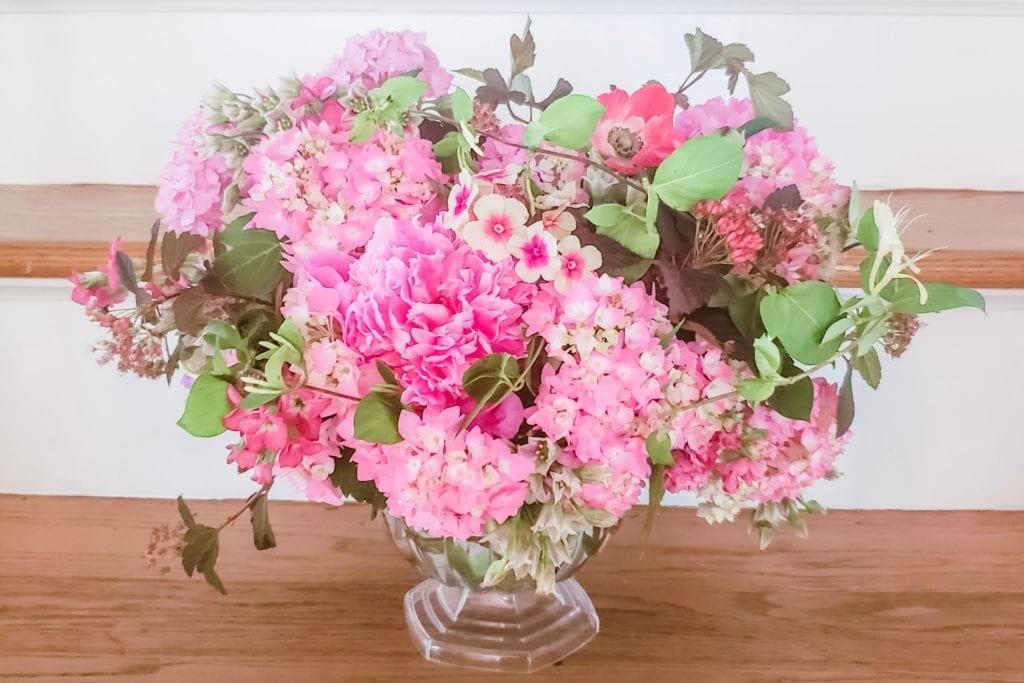
“But Blair, you talk about flowers ALL THE TIME. We know you think it’s cool already. Why should we care about American Grown Flowers? I just go to the grocery store and buy flowers that are pretty. Isn’t that enough? I’m buying flowers like you told me to!”
Well friends, it’s not just “cool.” It’s important, and it impacts our planet, and American businesses. I’m not usually one for numbers, but, in the spirit of this week, here are some statistics you may not know about the American flower industry.
- Americans spend between $7-$8 billion on cut flowers every year. American grown flower sales account for just 7% of that.
- There are 5,903 flower and foliage farms in the United States and they can be found in all 50 states! Think of how many jobs and families are tied to these farms! Imagine how many more jobs there could be if we were able to keep even half of the cut flower industry within our own country!
- 58% of American flower farms have gone out of business since 1992, mostly due to imported flowers being cheaper. I could write an entire blog post just about this issue, but for now I’ll say, free trade does not equal fair trade. Our US farmers have a hard time paying their employees a fair wage and competing with the cheaper labor that is available in other countries.
- 40k boxes arrive in the US DAILY from other countries. During the weeks of Mother’s Day and Valentine’s Day, this number is anywhere from 80-120k. This comes out to 7 flights a day, 6 days a week. Can you even imagine the amount of resources being used up to get these flowers here???
Are any of these numbers staggering to you?? They are to me too! Honestly, these numbers by themselves are enough for me to buy domestic flowers. But if you still need more reasons, read on!
Creative reasons for using American Grown flowers:
- Variety – the number of unique and interesting stems that you can get significantly increases when you start incorporating local farms into your list of sources for flowers. Sometimes I will just tell a farmer what colors I need, and they’ll just tell me what they have! I end up getting flowers I hadn’t even thought of and my designs become much more interesting.
- Fresh, so fresh – the flowers I get from flower farms are consistently fresher and longer lasting than imported flowers. They have not been dehydrated for a long plane ride, they were likely cut in the last few days (not last week, as in the case of imports). I will note that I find domestic flowers to be much “thirstier” than imported flowers, so it is important to check the water level each day!
- Community – there is a sense of partnership and collaboration when you can talk to your flower farmers about what they’re growing. The farmers want to know what flowers the florists want! They want to know what colors are trending, what we need more of, what we aren’t selling much of, and that can affect what they plant for the next season. Sometimes, a farmer will even plant something specifically for me, for a wedding that I want a specific flower for.
These two arrangements came mostly from Grateful Gardeners (Sarah wanted a big ol’ wildflower arrangement with no focal flowers! Ask and you shall receive!) and the hot pink peonies in the first image are from M&M Plants. What I loved about this day is that Sarah just brought over some flowers. I said I needed some line flowers, some focal flowers and some accent flowers and I gave her a budget. When you are working directly with a farm, you can do that! You can give a color palette, you can give a type of flower that you need, you can get their invaluable input on what to buy! We don’t always have to use typical flowers. The more new flowers you use, the more exciting your designs will be!
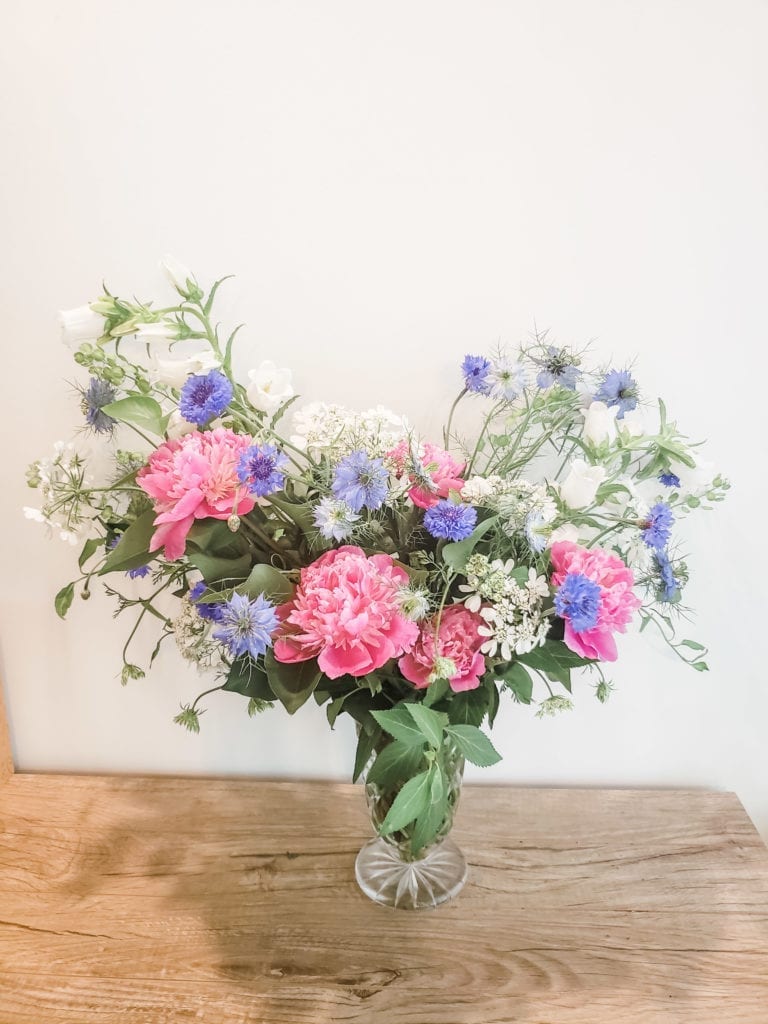
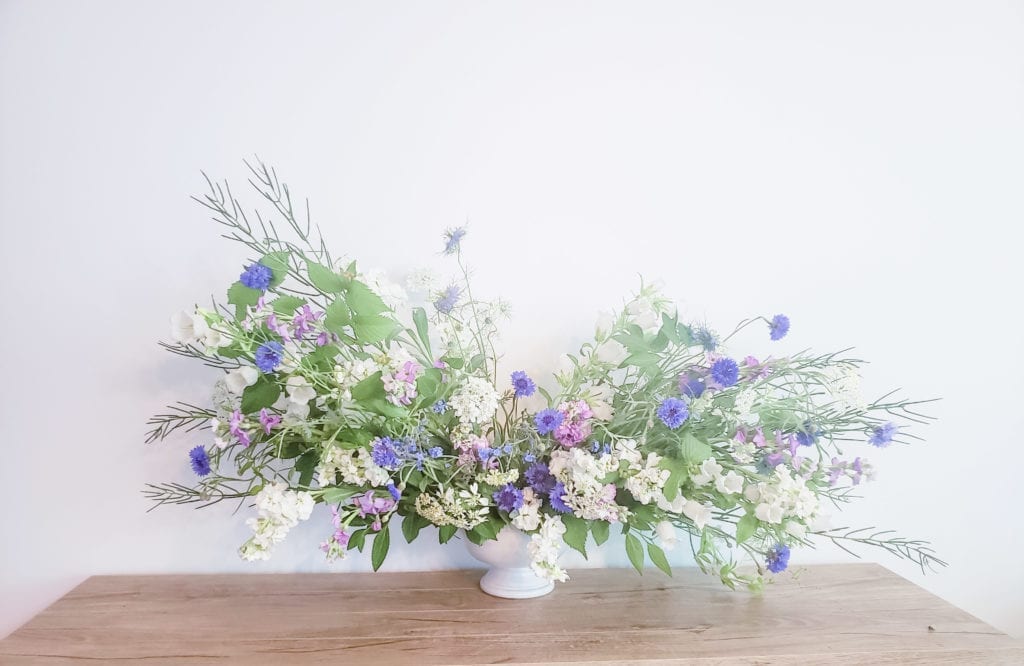
Economic and environmental reasons for using American Grown flowers:
- Supporting local businesses – When you buy from American Flower farms, you are supporting a small business. That business is attached to a family, and is a part of a local economy. You are providing wages and benefits that will be paid to local residents, and you are creating profits that are earned by local business owners. These wages and profits will be returned to the local economy to support schools, infrastructure and emergency services for that area. Also, bonus! Small businesses are more likely to purchase more local goods and services for resale and internal use, AND they are more likely to contribute to local nonprofits.
- Reducing your carbon footprint – Buying domestic flowers reduces your carbon footprint. The less miles your flowers have to travel to get to you, the less resources are used up on the way. Remember those crazy numbers I shared with you at the beginning of this post? All those plane rides across oceans, just to get flowers here?? Less fuel and less planes = less pollution for our planet. Additionally, domestic flowers typically use less packaging, which means less waste and less demand on landfills.
- Less pesticides! – If you’re not a florist, you may not realize this, but when I unwrap and process imported roses, my hands literally come away with a sticky residue on them when I’m done. This is from pesticides! Domestic farmers use much more sustainable growing practices and less pesticides. I can also put the flower waste into my compost heap without worrying about introducing pesticides into the groundwater.
These two arrangements are from another local farm co-op in my area, Monocacy Valley Flower Co-op. They are my main supplier of local product! These anemones were just to-die-for and the greenery are hosta leaves from my garden.
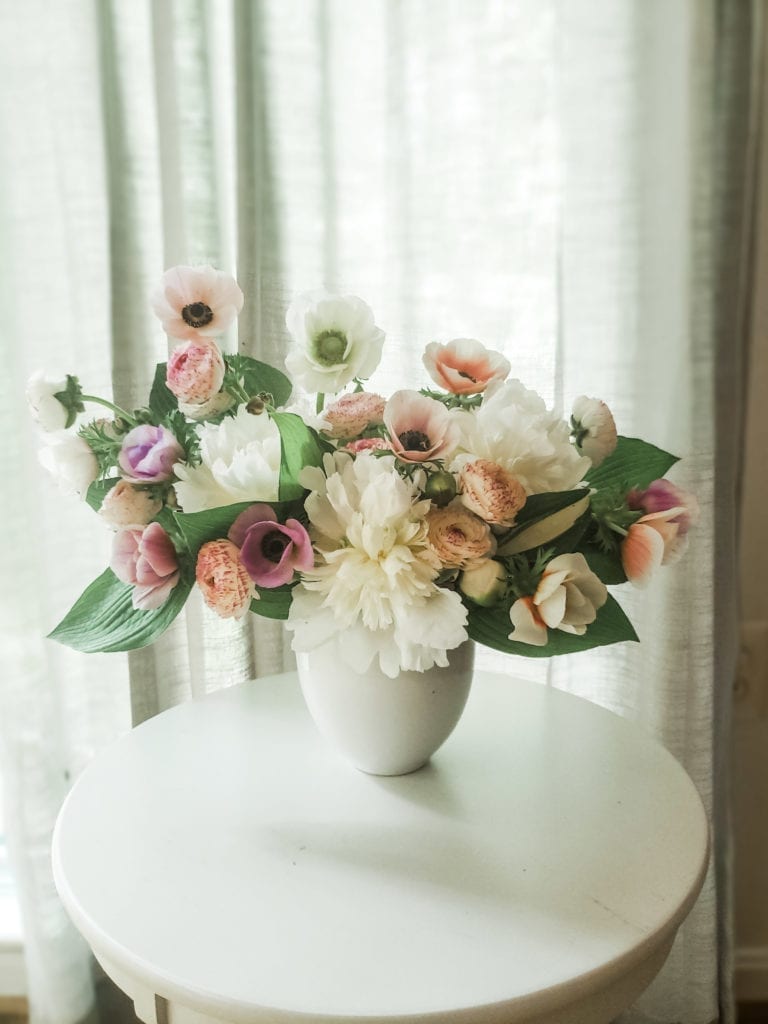
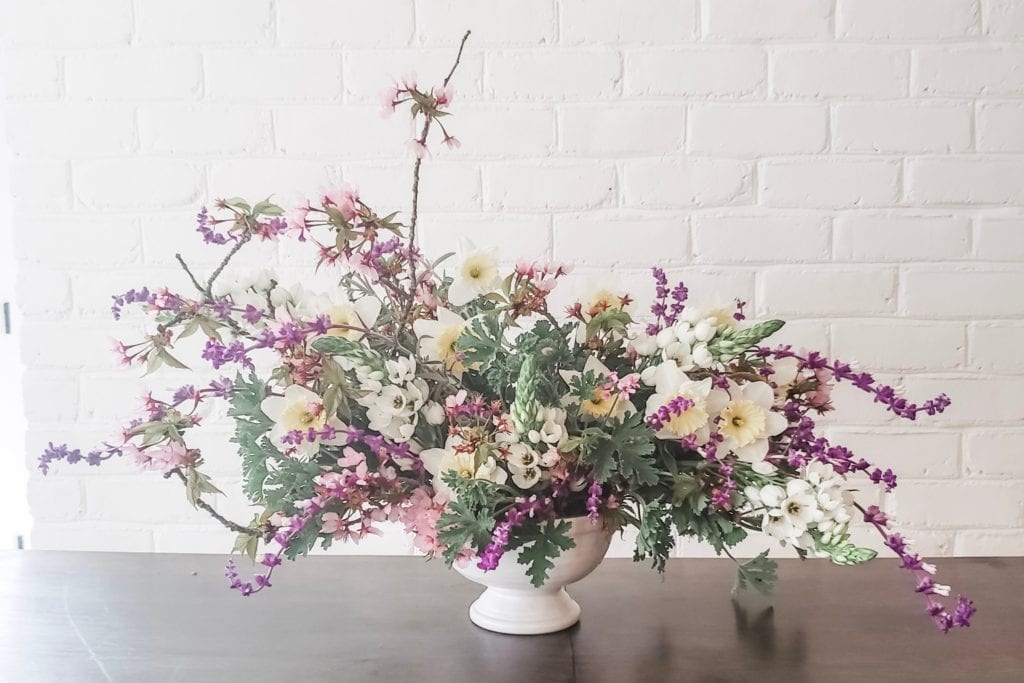
Before I end this long post, I want to say that this stuff is important whether you are a florist or just a lover of flowers. If any of these topics are important to you, pay attention to the flowers you purchase. If you buy grocery store flowers, you can look for the #Americangrown logo on the bouquets. There’s also one for #cagrown! If you are more of a farmer’s market type of person, you are almost guaranteed to be purchasing flowers straight from a flower farmer! If you’re getting married, ordering flowers for your home or ordering for a loved one, ask your florist where he/she sources flowers. Do they put a priority on domestic flowers? If it’s important to you, vote with your dollars. Where do your flowers come from?
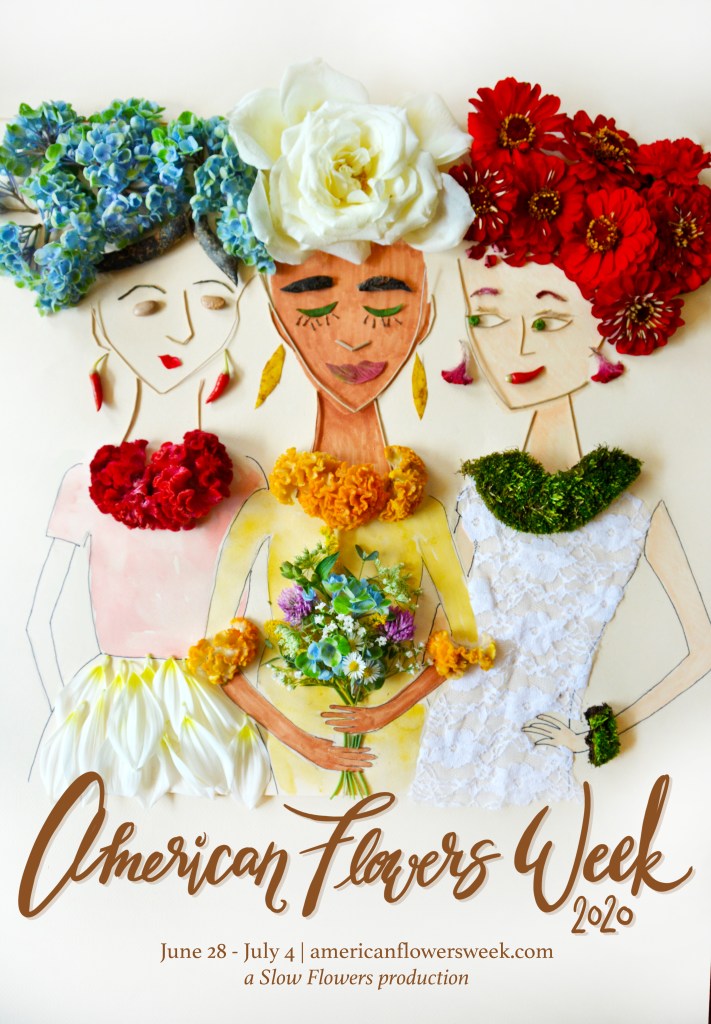
(above) Artist: Tamara Hough @morning.glory.flowers Graphic Design: Jenny Diaz @jannymdiaz
I really hope you have learned something from this post. For additional resources, please read on.
Source of these statistics and soooo much more information on American Grown Flowers: Slow Flowers Society
HERE is a brilliant article that goes into further detail about the economic benefits of shopping locally, if you are interested in more information.